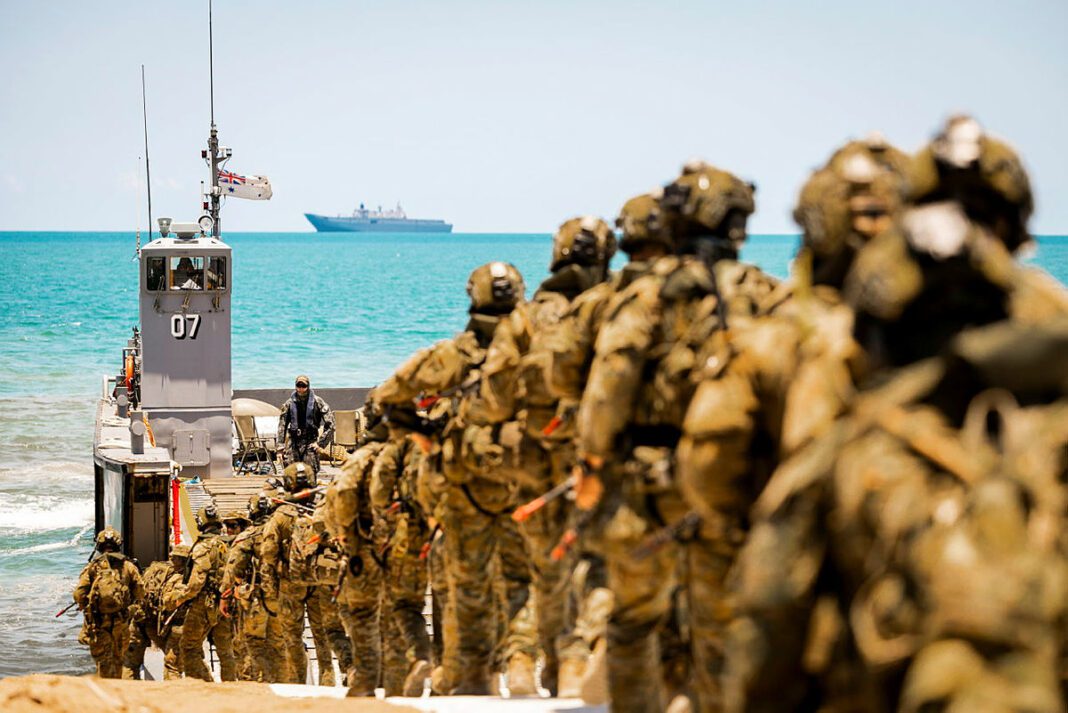The Australian Defence Force (ADF) and the Indonesian National Armed Forces (TNI) have launched a historic military exercise named Exercise Keris Woomera. Beginning on November 3, 2024, this joint activity is set to be the largest combined training mission between the two countries in recent years. The exercise aims to strengthen military cooperation, improve response to security challenges, and enhance both countries’ abilities to respond to natural disasters.
Largest Joint Operation in Recent Years
Exercise Keris Woomera comes on the heels of a significant defense pact between Australia and Indonesia—the Australia-Indonesia Defence Cooperation Agreement. Signed earlier this year, this agreement has laid a strong foundation for enhanced military cooperation and trust. Keris Woomera brings together around 2,000 military personnel from both nations, including members from their navy, army, and air force. Approximately 35 Indonesian military personnel are stationed aboard the HMAS Adelaide in Darwin, Australia, where they will train closely with Australian counterparts.
Activities Across Land, Air, and Sea
Exercise Keris Woomera will run throughout November, starting with training sessions in Indonesia. The combined operations will span air, maritime, amphibious (land-to-sea) movements, and land operations. One of the key highlights will be a simulated humanitarian assistance and disaster relief scenario. This training aims to help both nations’ forces quickly provide aid and evacuate people during real-world disasters, such as earthquakes or floods, common in the region.
Throughout the exercise, forces from both countries will conduct various operations to test and refine their tactics, strategies, and communication systems. By practicing together in realistic scenarios, the ADF and TNI aim to increase their ability to work as one efficient and effective team.
Simulated Disaster Response and Aid
The humanitarian aid segment of Exercise Keris Woomera holds special importance. In recent years, Indonesia has experienced numerous natural disasters, including earthquakes, tsunamis, and volcanic eruptions. By training together for disaster response, the ADF and TNI can improve their ability to deliver lifesaving assistance faster and more effectively.
During this part of the exercise, troops will practice evacuating civilians from dangerous areas, providing medical assistance, and coordinating safe zones. The exercise allows both forces to prepare for high-pressure situations, ensuring they’re ready to support each other and assist in times of crisis.
Combined Firepower Display
The exercise will end with a combined live-fire event, showcasing the full capabilities of both forces. Tanks, artillery units, infantry forces, and attack helicopters will join forces in a demonstration of their power. The live-fire exercise is a final test of the teamwork and tactical skills developed throughout Keris Woomera. This display will highlight how the ADF and TNI can work together in real-world combat scenarios, reinforcing security across the Indo-Pacific.
Strengthening Regional Stability
Exercise Keris Woomera is a key part of Australia’s Indo-Pacific Endeavour 2024, which is Australia’s largest regional engagement effort this year. The Indo-Pacific Endeavour program promotes regional stability and strengthens partnerships among countries in the Indo-Pacific. By building close military ties with Indonesia, Australia aims to maintain peace and cooperation in the region, especially as the region faces shared security concerns.
This partnership between Australia and Indonesia comes at an important time, as both countries recognise the need for unity in a region with diverse challenges, from climate-related issues to political tensions. Working together helps ensure both countries can respond quickly and effectively to any potential threats, fostering a safer environment for all.
Enhanced Training for Stronger Bonds
Exercise Keris Woomera goes beyond tactical skills. It also focuses on sharing strategies, techniques, and ideas to improve overall readiness. Training together lets soldiers, sailors, and pilots learn from one another, adding to their experience and strengthening their teamwork. During the exercise, both ADF and TNI personnel will practice coordination in complex situations, which builds trust and understanding between the two forces.
The training scenarios are designed to simulate realistic situations that ADF and TNI forces might face in the future. This approach allows the troops to practice responding to unexpected events, test communication strategies, and refine their technical skills. The training strengthens both forces’ ability to work side-by-side, building a foundation of teamwork that can be critical during actual operations.
Symbol of Australia-Indonesia Friendship
Exercise Keris Woomera highlights the deepening friendship between Australia and Indonesia. Both nations share a long history of collaboration, but this exercise marks a significant step forward in their defense relationship. By working together closely, both countries show their commitment to supporting one another and contributing to peace in the Indo-Pacific.
The inclusion of live-fire drills, humanitarian scenarios, and amphibious exercises makes Keris Woomera more than just a display of strength. It shows how two countries can prepare for a wide range of situations while strengthening their alliance. Through this cooperation, both countries are taking active steps to enhance security in the region.
Future of Australia-Indonesia Cooperation
With the conclusion of Exercise Keris Woomera, both Australia and Indonesia are set to continue building on this successful partnership. Regular joint exercises, discussions on defense strategies, and shared training initiatives will help the two countries stay prepared for new challenges. This exercise underscores a shared commitment to peace, security, and cooperation that will guide the future of Australia-Indonesia relations.
As the exercise progresses, military leaders from both sides hope to build a stronger, more adaptable force that can respond to the needs of both countries. This cooperation between Australia and Indonesia sets an example for the region, showing how working together can lead to a stronger, more resilient Indo-Pacific.

